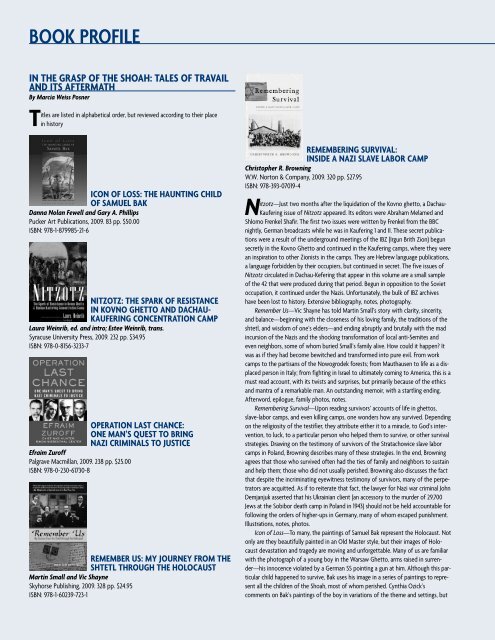reviews - Jewish Book Council
reviews - Jewish Book Council
reviews - Jewish Book Council
You also want an ePaper? Increase the reach of your titles
YUMPU automatically turns print PDFs into web optimized ePapers that Google loves.
BOOK PROFILE<br />
IN THE GRASP OF THE SHOAH: TALES OF TRAVAIL<br />
AND ITS AFTERMATH<br />
By Marcia Weiss Posner<br />
Titles are listed in alphabetical order, but reviewed according to their place<br />
in history<br />
ICON OF LOSS: THE HAUNTING CHILD<br />
OF SAMUEL BAK<br />
Danna Nolan Fewell and Gary A. Phillips<br />
Pucker Art Publications, 2009. 83 pp. $50.00<br />
ISBN: 978-1-879985-21-6<br />
NITZOTZ: THE SPARKOF RESISTANCE<br />
IN KOVNO GHETTO AND DACHAU-<br />
KAUFERING CONCENTRATION CAMP<br />
Laura Weinrib, ed. and intro; Estee Weinrib, trans.<br />
Syracuse University Press, 2009. 232 pp. $34.95<br />
ISBN: 978-0-8156-3233-7<br />
Efraim Zuroff<br />
Palgrave Macmillan, 2009. 238 pp. $25.00<br />
ISBN: 978-0-230-61730-8<br />
OPERATION LAST CHANCE:<br />
ONE MAN’S QUEST TO BRING<br />
NAZI CRIMINALS TO JUSTICE<br />
REMEMBER US: MY JOURNEY FROM THE<br />
SHTETL THROUGH THE HOLOCAUST<br />
Martin Small and Vic Shayne<br />
Skyhorse Publishing, 2009. 328 pp. $24.95<br />
ISBN: 978-1-60239-723-1<br />
REMEMBERING SURVIVAL:<br />
INSIDE A NAZI SLAVE LABOR CAMP<br />
Christopher R. Browning<br />
W.W. Norton & Company, 2009. 320 pp. $27.95<br />
ISBN: 978-393-07019-4<br />
Nitzotz—Just two months after the liquidation of the Kovno ghetto, a Dachau-<br />
Kaufering issue of Nitzotz appeared. Its editors were Abraham Melamed and<br />
Shlomo Frenkel Shafir. The first two issues were written by Frenkel from the BBC<br />
nightly, German broadcasts while he was in Kaufering 1 and II. These secret publications<br />
were a result of the underground meetings of the IBZ (Irgun Brith Zion) begun<br />
secretly in the Kovno Ghetto and continued in the Kaufering camps, where they were<br />
an inspiration to other Zionists in the camps. They are Hebrew language publications,<br />
a language forbidden by their occupiers, but continued in secret. The five issues of<br />
Nitzotz circulated in Dachau-Kefering that appear in this volume are a small sample<br />
of the 42 that were produced during that period. Begun in opposition to the Soviet<br />
occupation, it continued under the Nazis. Unfortunately, the bulk of IBZ archives<br />
have been lost to history. Extensive bibliography, notes, photography.<br />
Remember Us—Vic Shayne has told Martin Small’s story with clarity, sincerity,<br />
and balance—beginning with the closeness of his loving family, the traditions of the<br />
shtetl, and wisdom of one’s elders—and ending abruptly and brutally with the mad<br />
incursion of the Nazis and the shocking transformation of local anti-Semites and<br />
even neighbors, some of whom buried Small’s family alive. How could it happen? It<br />
was as if they had become bewitched and transformed into pure evil. From work<br />
camps to the partisans of the Nowogrodek forests; from Mauthausen to life as a displaced<br />
person in Italy; from fighting in Israel to ultimately coming to America, this is a<br />
must read account, with its twists and surprises, but primarily because of the ethics<br />
and mantra of a remarkable man. An outstanding memoir, with a startling ending.<br />
Afterword, epilogue, family photos, notes.<br />
Remembering Survival—Upon reading survivors’ accounts of life in ghettos,<br />
slave-labor camps, and even killing camps, one wonders how any survived. Depending<br />
on the religiosity of the testifier, they attribute either it to a miracle, to God’s intervention,<br />
to luck, to a particular person who helped them to survive, or other survival<br />
strategies. Drawing on the testimony of survivors of the Stratachowice slave labor<br />
camps in Poland, Browning describes many of these strategies. In the end, Browning<br />
agrees that those who survived often had the ties of family and neighbors to sustain<br />
and help them; those who did not usually perished. Browning also discusses the fact<br />
that despite the incriminating eyewitness testimony of survivors, many of the perpetrators<br />
are acquitted. As if to reiterate that fact, the lawyer for Nazi war criminal John<br />
Demjanjuk asserted that his Ukrainian client (an accessory to the murder of 29,700<br />
Jews at the Sobibor death camp in Poland in 1943) should not be held accountable for<br />
following the orders of higher-ups in Germany, many of whom escaped punishment.<br />
Illustrations, notes, photos.<br />
Icon of Loss—To many, the paintings of Samuel Bak represent the Holocaust. Not<br />
only are they beautifully painted in an Old Master style, but their images of Holocaust<br />
devastation and tragedy are moving and unforgettable. Many of us are familiar<br />
with the photograph of a young boy in the Warsaw Ghetto, arms raised in surrender—his<br />
innocence violated by a German SS pointing a gun at him. Although this particular<br />
child happened to survive, Bak uses his image in a series of paintings to represent<br />
all the children of the Shoah, most of whom perished. Cynthia Ozick’s<br />
comments on Bak’s paintings of the boy in variations of the theme and settings, but


